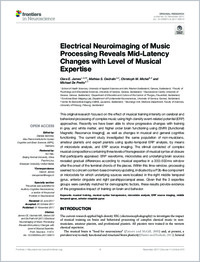Electrical neuroimaging of music processing reveals mid-latency changes with level of musical expertise
- James, Clara E. School of Health Sciences, University of Applied Sciences and Arts Western Switzerland, Geneva, Switzerland - Faculty of Psychology and Educational Sciences, University of Geneva, Switzerland - Neuroscience Center, University of Geneva, Switzerland
- Oechslin, Mathias S. Faculty of Psychology and Educational Sciences, University of Geneva, Switzerland - Department of Education and Culture of the Canton of Thurgau, Frauenfeld, Switzerland
- Michel, Christoph M. Functional Brain Mapping Lab, Department of Fundamental Neurosciences, University of Geneva, Switzerland - Center for Biomedical Imaging (CIBM), Lausanne, Switzerland
- De Pretto, Michael Faculty of Psychology and Educational Sciences, University of Geneva, Switzerland - Neurology Unit, Medicine Department, Faculty of Sciences, University of Fribourg, Switzerland
-
07.11.2017
Published in:
- Frontiers in Neuroscience. - 2017, vol. 11, p. 613
English
This original research focused on the effect of training intensity on cerebral and behavioral processing of complex music using high-density event-related potential (ERP) approaches. Recently we have been able to show progressive changes with training in grey and white matter and higher order brain functioning using (f)MRI ((functional) Magnetic Resonance Imaging), as well as changes in musical and general cognitive functioning. The current study investigated the same population of non-musicians, amateur pianists and expert pianists using spatio-temporal ERP analysis, by means of microstate analysis, and ERP source imaging. The stimuli consisted of complex musical compositions containing three levels of transgression of musical syntax at closure that participants appraised. ERP waveforms, microstates and underlying brain sources revealed gradual differences according to expertise in a 300-500 ms window after the onset of the terminal chords of the pieces. Within this time-window, processing seemed to concern context-based memory updating, indicated by a P3b-like component or microstate for which underlying sources were localized in right middle temporal gyrus, anterior cingulate and right parahippocampal areas. Given that the 3 expertise groups were carefully matched for demographic factors, these results provide evidence of the progressive impact of training on brain and behavior.
- Faculty
- Faculté des sciences et de médecine
- Department
- Médecine 3ème année
- Language
-
- English
- Classification
- Biological sciences
- License
- License undefined
- Identifiers
-
- RERO DOC 306283
- DOI 10.3389/fnins.2017.00613
- Persistent URL
- https://folia.unifr.ch/unifr/documents/306224
Statistics
Document views: 64
File downloads:
- pre_enm.pdf: 127
